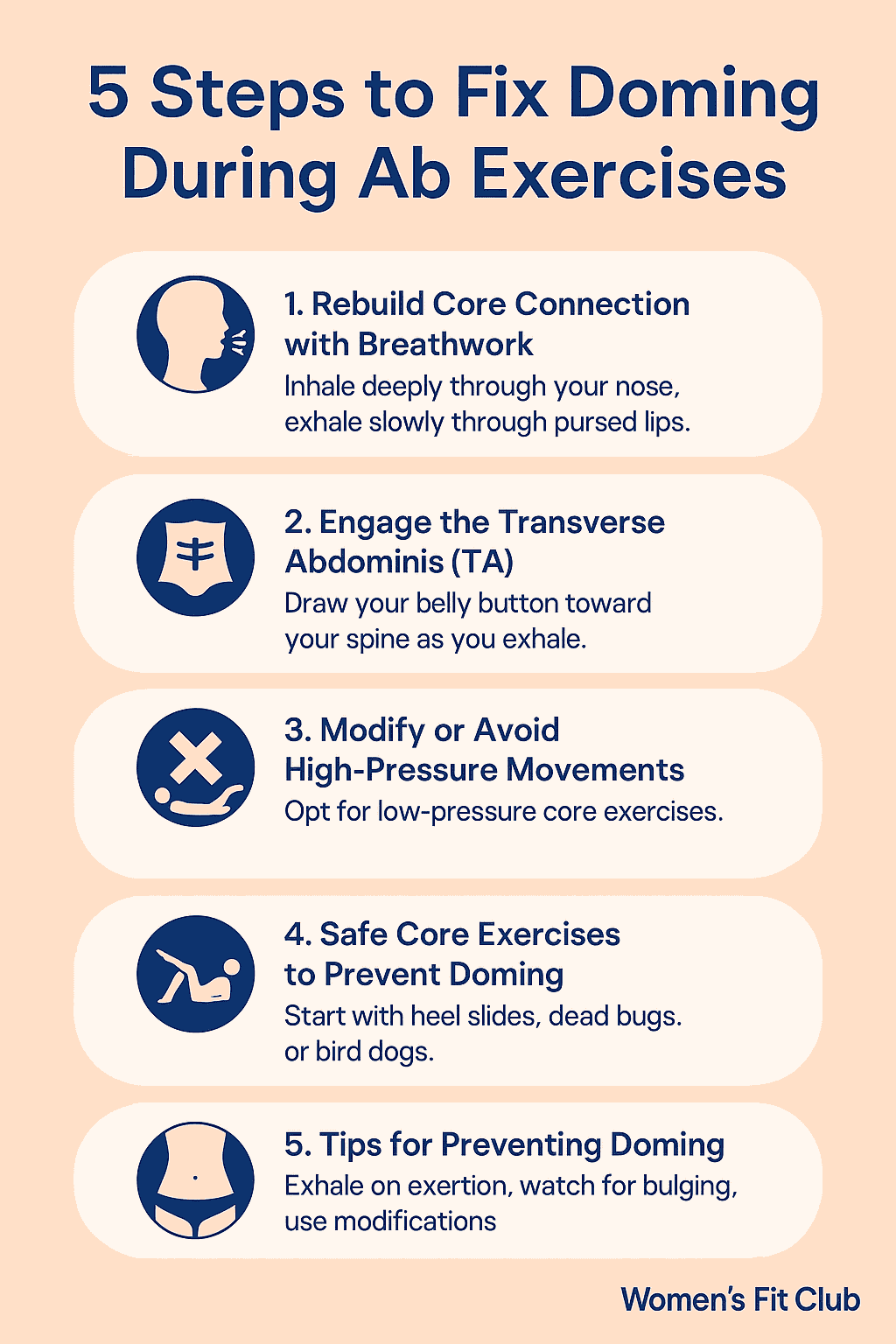Sign up for workout ideas, training advice, reviews of the latest gear and more.






When you’re working hard on your abs, noticing your belly bulging or “doming” during exercises can be concerning. It’s common to see your midline push outward when you do sit-ups, crunches, or planks—but this doming isn’t just a cosmetic issue. It’s a sign that your core muscles aren’t engaging correctly.
Learning how to fix doming during ab exercises is crucial for preventing injury, protecting your pelvic floor, and building real, functional core strength. In this comprehensive guide, we’ll explain what doming is, why it happens, and exactly how to fix it with safe techniques and corrective exercises.
Doming refers to a visible bulge or ridge that appears along the center of your abdomen—usually from your sternum down toward your belly button—when performing core movements. It’s most noticeable during sit-ups, leg lifts, or planks.
This bulge forms when intra-abdominal pressure pushes the abdominal wall outward, often through the linea alba (the connective tissue between your left and right abdominal muscles). This happens when your deep core muscles, particularly the transverse abdominis, aren’t properly engaged.
Doming can occur for several reasons, and understanding the cause helps you fix it effectively.
The transverse abdominis (TVA) acts like a natural corset, pulling your abdomen inward and stabilizing your spine. If the TVA isn’t activated, your rectus abdominis (six-pack muscle) takes over, pushing the abdomen outward.
Doming is a common sign of diastasis recti, a separation of the abdominal muscles that often occurs during or after pregnancy. When the connective tissue between the abs stretches or weakens, pressure causes a visible bulge.
Holding your breath or breathing into your chest during core work increases intra-abdominal pressure, causing your stomach to push out rather than draw in.
Improper exercise technique—such as pulling your neck in crunches or letting your lower back arch during planks—can cause your core to disengage and pressure to build outward.
Jumping into advanced ab exercises (like hanging leg raises or V-ups) without mastering foundational core control can lead to doming because your deep core isn’t yet strong enough to stabilize your body.
You can check for doming by following these steps:
You may also notice doming in planks, push-ups, or leg lifts. Any time your abs push outward rather than flatten, your core isn’t properly engaged.
Doming is more than just a visual issue—it signals core dysfunction. Ignoring it can lead to:
Addressing doming early helps rebuild proper core strength and ensures your workouts enhance—not harm—your body.

The goal isn’t to stop exercising your abs—it’s to retrain your core muscles to work safely and effectively. Below are proven strategies and exercises to correct doming.
The first step is learning to control your breath and engage your deep core correctly.
This helps you reconnect to your transverse abdominis and pelvic floor.
How to do it:
This type of breathing reduces pressure and teaches your body to stabilize your core naturally.
Once you’ve mastered diaphragmatic breathing, you can activate your deep core.
This “corset” action is the foundation for all future ab movements. You should feel your lower abs tighten without pushing outward.
During your recovery or retraining phase, avoid exercises that cause doming:
Instead, start with low-pressure core exercises that strengthen your deep abdominal wall.
Let’s explore effective exercises that retrain your core and eliminate doming.
A gentle way to strengthen your core while maintaining abdominal control.
How to do it:
This exercise improves core stability and spinal alignment.
How to do it:
A great way to engage the obliques and deep core muscles without high pressure.
How to do it:
Strengthens the back and abdominals while improving balance.
How to do it:
Ideal for reconnecting to your core and correcting posture.
How to do it:
Even as you progress to more advanced moves, these cues help prevent doming:
Always breathe out on the hardest part of the movement—like lifting your legs or crunching up. Exhaling helps activate your deep core and control pressure.
If you notice any bulging or coning, stop and reset your form. Focus on pulling your belly inward.
Before any movement, take a deep breath, exhale, and gently draw your belly button toward your spine. Then perform the exercise.
You don’t need to skip ab training—just modify. Try:
These variations reduce abdominal strain while allowing you to strengthen safely.
The Valsalva maneuver (holding your breath during strain) increases internal pressure, making doming worse. Keep your breathing smooth and controlled.
If doming persists despite corrections, consider consulting:
They can assess whether diastasis recti or pelvic floor dysfunction is contributing and design a personalized recovery plan.
After mastering core control, you can gradually add more challenging movements. Focus on maintaining a flat abdomen and proper breathing.
These controlled, functional exercises help strengthen your core safely once you’ve retrained your deep muscles.
For many women, especially postpartum, doming indicates diastasis recti, where the abdominal wall has separated due to pregnancy or strain. The strategies to fix doming—breath control, core activation, posture—are the same techniques used in diastasis recti recovery.
Over time, consistent practice can reduce the separation, restore tension in the connective tissue, and flatten your abdominal wall.
Before performing any ab exercise, ask yourself:
Am I breathing steadily?
Is my belly flat or slightly pulled inward?
Is my spine neutral (not arched or rounded)?
Do I feel my deep core working rather than pushing out?
If you answer “no” to any of these, reset your form or modify the movement.
Healing from doming isn’t just about exercise. Daily habits also affect your core health.
Stand tall with ribs stacked over hips. Avoid letting your belly hang forward, which strains your core.
When picking up kids, groceries, or weights, exhale and tighten your core gently before lifting.
Straining during bowel movements increases intra-abdominal pressure, similar to doming. Drink water, eat fiber, and practice proper breathing.
Running, jumping, or heavy lifting can worsen doming if your core isn’t ready. Rebuild stability first.
Fixing doming isn’t about quick fixes—it’s about retraining your core from the inside out. With consistent practice, most women notice improvement within 4–8 weeks, depending on severity and daily habits.
Consistency in breathwork, engagement, and mindful movement will help restore your core’s integrity and make your abs not only look stronger—but function better.
Doming during ab exercises doesn’t mean you should stop working out—it means you need to train smarter. By rebuilding your deep core foundation through breath, control, and proper activation, you’ll not only eliminate doming but also improve your overall posture, stability, and strength.
Remember: a strong core starts from within. Train your body to move with awareness and your abs will follow.
Want more workout and video guide?
Follow us on Pinterest, Facebook, and Subscribe to our Newsletter and Stay tuned for FREE downloads of our App coming soon!
Stay up to date on the latest women’s health, fitness and lifestyle trends and tips.